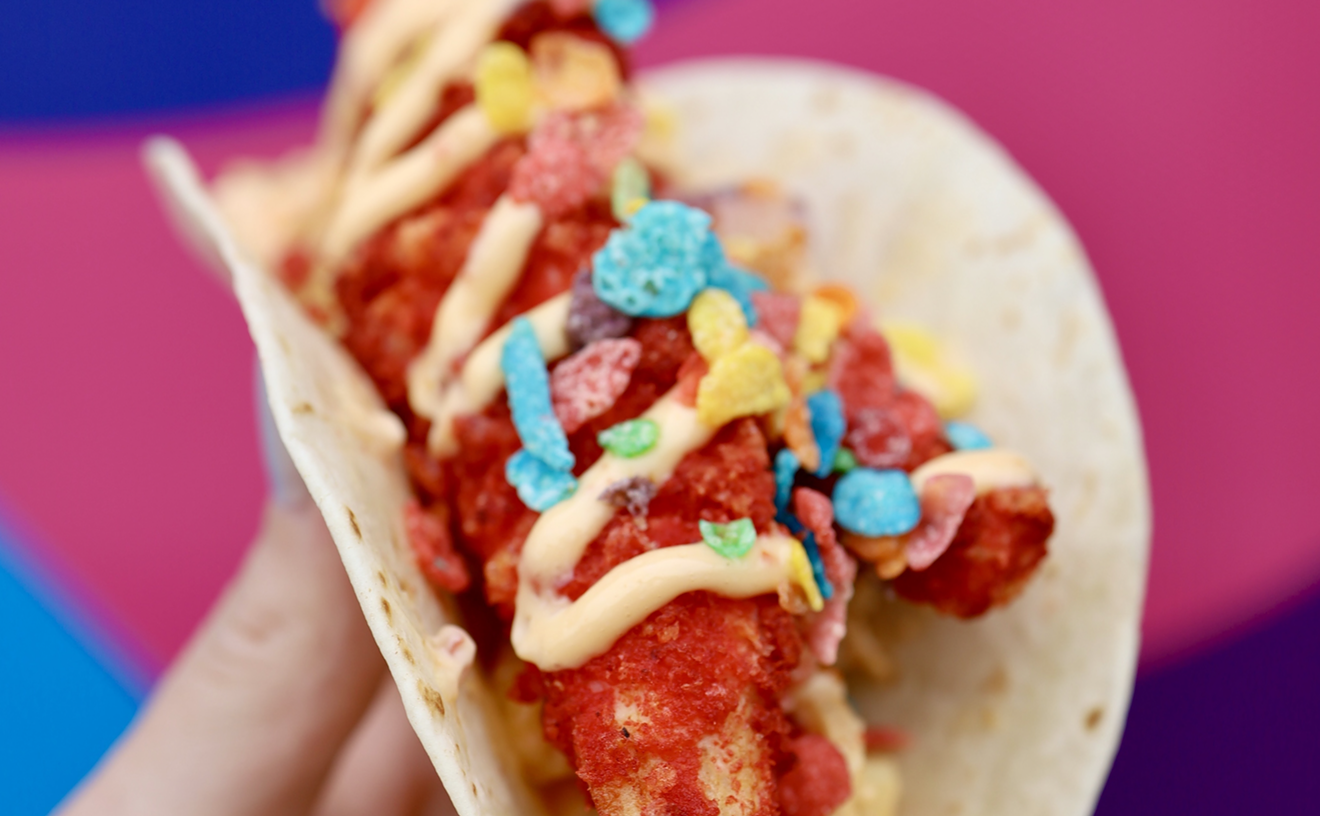The new 1500 Degrees, unveiled in October as the final piece in the Eden Roc Renaissance's $220 million renovation, dubs its menu "farm-to-table eating, with a heavy steakhouse sensibility." That's as good a self-description as you'll get from a restaurant.
Executive chef Paula DaSilva spent a decade as Dean James Max's chef de cuisine at Fort Lauderdale's 3030 Ocean, and — an even greater testament to her endurance — toiled for weeks under Gordon Ramsay on Hell's Kitchen. That's called paying dues. The Brazilian native brings a more heavenly style of heat to the Eden Roc — through steaks, seared at the namesake 1500 degrees, and local vegetables, cooked with a lover's devotion. Those are two good reasons to visit this establishment.
The 160-seat, earth-toned dining room is less of a draw. Handsomely draped in dark woods, light bricks, and leather-padded columns, it boasts a partially open kitchen and eat-in bar. But the décor suggests farm ambiance as envisioned by middle-aged businessmen: vintage milk cans and a communal butcher block table in an otherwise staid corporate setting. The nicest decorative touches are the space's six original chandeliers, now wrapped in translucent canvas lampshades that provide soft lighting and cast tree-like silhouettes. Air conditioning worked just fine on the 40-degree night we dined there; we hardly had to acclimate upon entering. Music consisted mostly of songs overplayed on Sixties oldies stations, but you can avoid enduring "Brown Eyed Girl" yet again by choosing one of the 40 additional seats on a poolside patio.
Assembling an affordably priced meal at 1500 Degrees is easier than you might imagine. One way to do so is ordering the three-course, daily-changing tasting menu for $35 (just ten dollars more if paired with wine). Another money-saving tip is to skip raw bar selections ($13 to $30) and "first" plates ($10 to $15), and start instead with a couple of "small plates" ($5 to $12). This is a savvy strategy even beyond scrimping: You can get raw selections such as Kumamoto oysters, chilled lobster, and shrimp cocktail in lots of spots around town, and first plates mostly consist of salads (Caesar, baby bibb, tomato with burrata and speck). Small plates, however, present farm-fresh vegetables prepared with tremendous aplomb. Shishito peppers with just a bit of salt and lime, charred Brussels sprouts with mustard sauce, roasted beets with Hani's goat cheese and marcona almonds — chef DaSilva coaxes the natural flavors from each without burdening them with unnecessary garnishes. Jumbo lump crab salad, the priciest item, validates its value via plump pearls of backfin laced with julienned strips of apple and piquillo pepper, and a light mist of citrusy dressing. Local greens tossed in vinaigrette come alongside.
A caveat: Bypass the small plate of pork belly tacos. The trio of deep-fried bellies were tasty enough (if a bit too chicharron-like), and kimchee at the bottom of the mini taco shells provided a pleasant kick... but why buy greasy street food when you're so close to farm-fresh produce? I kept asking myself that as I diddled over the middling dish.
Another way to trim the final tab: Forget about the Florida grass-fed Wagyu ribeye for $41, and instead cast your lot with a $25 prime top sirloin picanha. This Brazilian cut, also known as "rump cover," has a thick cap of fat that melts into and tenderizes the meat as it cooks. 1500's version came as a large hunk cut in two, each piece brightly seasoned, crisply seared, fully flavored, and boasting filet mignon-like texture — an exceptional steak cooked perfectly. The Wagyu flavor was better-than-ordinary, too, but the steak looked flat and uninspiring on the plate, and lacked the thick, sizzling excitement of the picanha. Plus I'd swear the ten-ounce sirloin was weightier than the 14-ounce ribeye.
Three of the seven steaks from the broiler cost $25 and under (the others being eight-ounces of skirt or Creekstone Farms all-natural bavette steak); beef tenderloin goes for $34; a dry-aged Kansas City strip costs $44; and a center cut of prime porterhouse for two costs $94. It costs two dollars extra for an accompanying sauce such as horseradish crème fraîche, béarnaise, spicy piquillo pepper chutney, or foie gras butter; and three dollars for a fried duck egg atop the meat. Really, though, these steaks don't need to be dressed.
As they come à la carte, however, you might want to fill out the plates with a couple of side dishes. These are divvied into $7 and $10 categories, and provide more proof of DaSilva's vibrancy and versatility regarding produce. Included in the low-end group are sweet buttered corn, broccoli rabe with garlic, yellow wax beans with almonds, wild baby carrots, and a few starches. The ten-buck division includes fat stalks of grilled asparagus, creamed spinach, braised mustard greens smoked and flecked with sultry Benton's bacon, and potato gratin layered with Vidalia and baked under a dome of the sweet onion (you won't find a better rendition in town). Duck fat steak fries brought six fat, soft, meaty, neatly stacked sticks. For $10, one might expect a few more logs tossed onto the pile.
Moist Carolina rice studded with cubes of chorizo is another alluring à la carte side, and one that automatically comes with a main course of rotisserie chicken — one of a half-dozen composed "specialty entrées" ($25 to $33). The juicy half-bird, locally raised, is likewise paired with a smudge of black bean purée and deliciously sautéed mustard greens. Fresh, green chick peas were a real treat as accompaniment to a baseball-sized wedge of olive oil-poached swordfish noticeably imbued with the fruity and pungent flavors of olives. Gently roasted, very red tomatoes dotted with dill, Niçoise olives, a confit of fennel, and drizzles of rouille (a paste made with red chiles, garlic, olive oil, and fresh bread crumbs) were also plated with the fish. These are the sort of thoughtfully chosen, meticulously cooked vegetables that entrées in so many local fine dining restaurants lack.
Desserts, overseen by DaSilva and pastry chef Jenny Rissone, weren't up to snuff in relation to the rest of the cuisine. A round, single-serving of pecan tart came with over-baked crust, although it also featured a quenelle of luscious vanilla ice cream. A goat cheese cheesecake came as four stiff little squares with crumbs on the side — the type of silly compilation that gives deconstruction a bad name. The cubes were pooled in port wine sauce and capped with a half-strawberry each, not nearly as fetching as promised figs.
It was the same old story regarding service: Waiters were friendly and fairly competent, but not trained in the finer aspects of their job. My knife dropped to the side of the table while I ordered, and it was still there when we left; that wouldn't happen with an attentive staff. When the manager roamed the room, the workers seemed to step it up; when he was gone, they slacked. As per usual, on one occasion it took forever to get the check even though the room wasn't crowded. Such service, and the insipid setting, serve to undercut the carefully crafted cuisine of DaSilva and her kitchen crew. Food as artful as this deserves a nicer frame.











